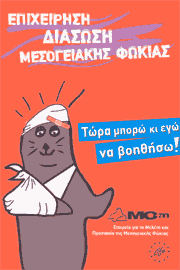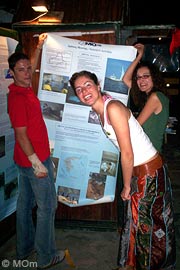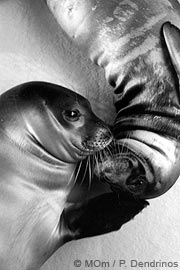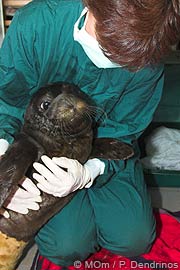

 |
||
 |
||
Vol. 9 (2): November 2006 |
||
Algeria / Greece / Italy / Madeira / Mauritania & Western Sahara / Spain / Turkey
Algeria
|
 |
|
|
|
A clear, practical and comprehensive guide that covers the essentials of what to do if you encounter a monk seal that needs help has been published by MOm. The First Aid to Seals guide aims to involve the people of island and coastal communities in the survival of the No. 1 critically endangered marine mammal in Europe. The guide was designed by MOm’s Seal Rescue Specialist and Veterinary Assistant and edited by its Communications Officer, in order to be easily understood by non-specialists. Photographs and illustrations are used to present the material in a clear and attractive way. Its water-resistant cover makes it practical in the field.
The booklet covers:
Locals of the 7 MOFI hot spot areas will also be given the opportunity of practical first aid training, through a series of seminars. The first rescuing techniques seminar will take place this winter on the island of Alonnisos, the heart of the National Marine Park of Alonnisos, Northern Sporades. – Calliope I. Lagonika, Mom.
 |
|
|
|
A total of 21,121 visitors to MOm’s Information Centres and kiosks were introduced to the Mediterranean monk seal this summer, thanks to the organisation’s Summer Volunteers’ Programme. MOm’s volunteers on the islands of Alonnisos, Skopelos and Kimolos, key habitats of the species, proved once again that they are valuable assets in bringing this vital conservation message to the public.
MOm’s Summer Volunteers’ programme has been operating since 1990, involving more than 850 volunteers ranging from 18 to 70 years of age! This year, MOm received almost 200 applications to participate, of which, following careful evaluation, 64 individuals were chosen to serve within the organisation’s volunteer staff for a fortnight each, receiving free accommodation. After a crash course on the biology and ecology of the monk seal as well as MOm’s actions and projects, they are ready to undertake a variety of tasks, ranging from environmental education for children to informing the public about the status of the monk seal in Greece. For more information on the Summer Volunteers’ programme, contact MOm at: . – Calliope I. Lagonika, Mom.
With the monk seal reproductive period fast reaching its peak for the Greek populations, MOm’s researchers report that 20 pups have already been born in various shelters in island Greece, a number that is expected to grow in the weeks to come.
The numbers are as follows:
National Marine Park of Alonnisos - Northern Sporades (NMPANS): 8 newborn pups recorded in October-November.
Kimolos-Polyaigos island complex: 11 newborn pups recorded in October.
Other areas: 1 newborn pup recorded in the islet of Spetsopoula, in the western part of the Aegean Archipelago.
MOm’s field research team will continue to monitor pupping sites in the NMPANS and the Kimolos-Polyaigos island complex and also plans to visit other important areas for monk seals. In parallel, the Rescue and Information Network (RINT) is also on full alert, gathering information on monk seal encounters and new-born pup sightings from observers all over coastal Greece. MOm is hopeful that by the end of the current reproductive period the tally will surpass the 26 pups recorded in 2005. – Vangelis Paravas, Mom.
 |
|
|
|
A true Mediterranean beauty featured in MOm’s photo exhibition “Fokogenia”, held in Athens during July and August 2006. A total selection of 30 high quality Monachus monachus photos captured the public’s and media’s imagination, in the first-ever monk seal photo exhibition to be organised in Greece.
The aim of the exhibition, which was accompanied by public awareness activities, was to impress upon people the importance of protecting the Greek marine wildlife.
The exhibition photographs were taken by MOm’s Head of Research, biologist and photographer, Panos Dendrinos. – Calliope I. Lagonika, Mom.
Very few studies have examined the dietary preferences of the Mediterranean monk seal, Monachus monachus, and none have extensively researched those of the population in the eastern Mediterranean, until now. MOm, in association with the Zoology Department of the University of Aberdeen in Scotland, has undertaken a wide-ranging study into the food preferences of the monk seal, as part of the Monk seal and Fisheries Project (MOFI), the only EU LIFE-NATURE programme granted to Greece for the year 2005.
The preliminary results of the study were based on the analysis of 18 stomach samples and 14 scat samples collected from monk seals by MOm's research team on Greek shores during the past 15 years. The results indicate that the species primarily feeds upon the common octopus, Octopus vulgaris, followed by the squid, Loligo vulgaris. The results concur with the findings of previous studies in the eastern Mediterranean, showing that cephalopods seem to be the preferred prey of monk seals. A variety of fish species have also been identified as prey including: Congridae (conger eels), Torpedinidae (kinds of ray), Scorpaeniformes (mail-cheeked fish) and Mugilidae (mullets). Suspected prey species also include Atherinidae (silversides), Sparidae (sea breams) and Anguilliformes (eels).
The difficulties involved in such a study are numerous and are attributable to the difficulty of identifying prey remains due to digestion in the stomach, the animal's state of health (before death), etc. Coupled with this is the fact that there is also only a limited bibliography on identifying certain prey species. Nevertheless, it is hoped that the study, which will be completed in 2008, will shed light on the little understood diet of the monk seal and prove useful in understanding seal-fisheries interactions. – Calliope I. Lagonika, Mom.
In June 2006, after about 2 years of delay that practically led to a halt in any effective management of the key protected areas in Greece, the Hellenic Ministry of Environment finally announced new Boards of Directors for the Management Bodies of most protected areas, including the two protected areas directly related to the conservation of the Mediterranean monk seal, the National Marine Park of Alonnisos- Northern Sporades (NMPANS) and the island of Karpathos.
In the Sporades Marine Park, MOm has again been appointed a voting member on the Board, and reports that the new Chairman, Prof. Ch. Neofytou, seems eager to start work. However, the chronic difficulty in drawing funds from the Ministry’s limited budget for protected areas and the managerial chaos left by the former chairman, another academic personally selected by the previous Deputy Minister, allows only limited hope for substantial progress in the effective protection of the largest marine park of the country. Though the situation in Karpathos is not substantially different, MOm, appointed as a member of the Board for the first time, is pushing the new Management Body to take immediate steps for the official designation of the area as protected and to set up key conservation actions. – Spyros Kotomatas, Mom.
 |
|
|
|
In an unprecedented initiative, several Greek NGOs, led by MOm, the Hellenic Ornithological Society and WWF Hellas, launched a campaign in early summer on behalf of the country’s NATURA 2000 sites.
Apart from showcasing the natural wealth of these areas, the media campaign’s central aim is to present to the general and local public the key argument that nature conservation is potentially the only alternative for the economic development of these remote and underdeveloped areas of the country.
It isn’t uncommon for some local communities and politicians to view nature conservation as an impediment to local development, which up to date has been mostly based on unplanned urban expansion and tourism growth. In parallel to this proactive initiative, Greek NGOs continue to pressure the Greek government to fulfil its obligations towards the effective management of the country’s protected areas, and the EU – notably Mr. S. Dimas, the Greek Commissioner for the Environment – to take the necessary legal action against Greece for its increasing number of clear violations of EU nature conservation legislation. – Spyros Kotomatas, MOm.
 |
After receiving an emergency call from the local port authorities of Oreo, Evia on 2/11/2006, MOm’s Rescue Team located a male pup, two weeks of age, washed up on a local beach near an aquaculture installation. The wounded and badly dehydrated pup was given first aid and immediately rushed to Athens for further examination.
On Friday 3/11/2006, the pup underwent treatment for anemia by MOm’s Rescue Team and a veterinarian from the University of Thessalonica. Despite every effort, however, the pup died a day later.
According to the results of the autopsy, the cause of death was anemia, caused by Hookworm infection. The autopsy was conducted by Professor of Comparative Pathology, Thijs Kuiken, of Erasmus University, Rotterdam, on Sunday 4/11/2006.
Seals may carry and transmit Hookworms via nursing, but are not affected by them. Still, in the case of Monachus monachus pups, Hookworms may prove to be fatal, as in the case of the stranded Evia pup. – Calliope I. Lagonika, MOm.
Mediterranean News continues with Italy, Madeira, Mauritania & Western Sahara, Spain and Turkey...
Copyright © 2006 The Monachus Guardian. All Rights Reserved |